Budget Priced Professional Camera
by John Henshall
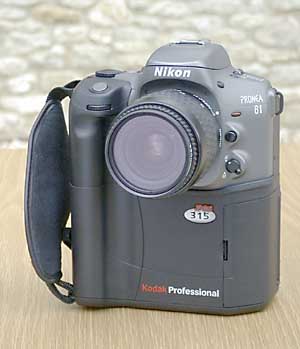
Hot on the heels of Kodak's DCS520 (Chip Shop April 1998) comes the DCS315 at less than half the price - £4,990 including lens, PCMCIA storage card and other essential accessories.
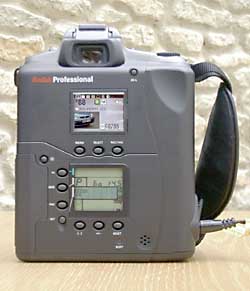 The
Kodak Professional DCS315 is housed in a Nikon Pronea 600i
APS SLR body and replaces the DCS410, a de-featured version
of the DCS420 which was itself replaced by the DCS520. Few
professionals are likely to have heard of the Nikon Pronea
600i, Nikon's first APS SLR introduced in 1997. In itself
this could hardly be considered to be a professional camera,
though it does have the ability to take their standard 35mm
Nikon F mount lenses and has a small built-in pop-up flash.
However, it is likely to appeal to professionals more than
most of the quirky integral lens cameras with which the
digital market is now saturated. When packed with all
Kodak's advanced digital stuff it certainly does become a
serious professional instrument. In my review of the DCS520
I suggested that Kodak should put their CCD chip into a
Canon APS body, where it would almost fill the 30.2 x 16.7mm
frame area. In the event, Kodak chose a Nikon APS but never
mind, this will appeal to many Nikon users who want a
digital camera.
The
Kodak Professional DCS315 is housed in a Nikon Pronea 600i
APS SLR body and replaces the DCS410, a de-featured version
of the DCS420 which was itself replaced by the DCS520. Few
professionals are likely to have heard of the Nikon Pronea
600i, Nikon's first APS SLR introduced in 1997. In itself
this could hardly be considered to be a professional camera,
though it does have the ability to take their standard 35mm
Nikon F mount lenses and has a small built-in pop-up flash.
However, it is likely to appeal to professionals more than
most of the quirky integral lens cameras with which the
digital market is now saturated. When packed with all
Kodak's advanced digital stuff it certainly does become a
serious professional instrument. In my review of the DCS520
I suggested that Kodak should put their CCD chip into a
Canon APS body, where it would almost fill the 30.2 x 16.7mm
frame area. In the event, Kodak chose a Nikon APS but never
mind, this will appeal to many Nikon users who want a
digital camera.
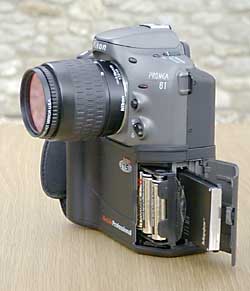 The
lightweight 24 - 70mm lens somehow seemed unlike a real
Nikkor in solid quality but the bigger disappointment was
when I put the viewfinder to my eye and saw the postage
stamp frame outline in the middle of the screen. To make
matters worse, this effectively gives our beloved Nikkors a
2.6x range extension - great if you like long tele lenses,
not so good if you want wideangles. IX-type Nikkors for the
APS SLRs have a 1.7x factor. Seven year ago - even four when
the DCS420 came out - this was an understandable limitation
but it's now time for a solution. New viewfinder optics - a
magnifier - could mask this drawback: it really is difficult
to peer at a much reduced viewfinder image. One alternative
is the use of relay optics, but these necessitate specially
designed bulky camera bodies and have other problems. The
best solution is a CCD which covers the whole film plane.
Philips now have a 24 x 36mm CCD. Watch this space.
The
lightweight 24 - 70mm lens somehow seemed unlike a real
Nikkor in solid quality but the bigger disappointment was
when I put the viewfinder to my eye and saw the postage
stamp frame outline in the middle of the screen. To make
matters worse, this effectively gives our beloved Nikkors a
2.6x range extension - great if you like long tele lenses,
not so good if you want wideangles. IX-type Nikkors for the
APS SLRs have a 1.7x factor. Seven year ago - even four when
the DCS420 came out - this was an understandable limitation
but it's now time for a solution. New viewfinder optics - a
magnifier - could mask this drawback: it really is difficult
to peer at a much reduced viewfinder image. One alternative
is the use of relay optics, but these necessitate specially
designed bulky camera bodies and have other problems. The
best solution is a CCD which covers the whole film plane.
Philips now have a 24 x 36mm CCD. Watch this space.
Many of the 'compact type' digital cameras have optical viewfinders which give only approximate indications of the field of view. We do not expect this in a professional camera. It was not until I noticed that parts of my images were missing from the acquired images that I became suspicious. Surely my framing was not this bad? I carefully photographed the new ISO Resolution Charts for Electronic Still Cameras. Along the bottom of the frame, the viewfinder showed very slightly less than the CCD records. On the right of the frame, it showed very slightly more than recorded. Both these are reasonably accurate. But on the left and at the top of frame the viewfinder showed much more than the CCD recorded - a big error and enough to cause concern to any professional.
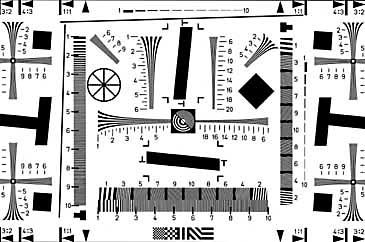
ISO Resolution Chart as framed in the viewfinder.
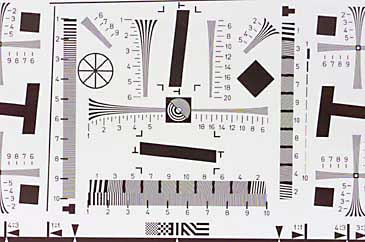
The ISO Resolution Chart as recorded by the camera.
CCD pixels are expensive, so accurate viewfinders are essential. We do not want viewfinders which show much less than they record because cropping to get back to our intended framing wastes these valuable pixels. But viewfinders which show more than the CCD actually records are a liability. This error must be corrected without delay in a professional digital camera. In the meantime, I advise you to test viewfinder accuracy carefully before buying.
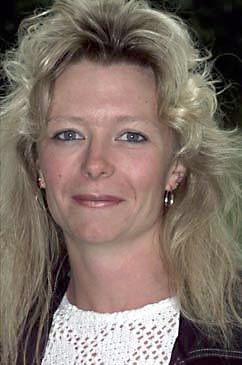 Despite
these criticisms, my overall impression of the DCS315 is one
of Kodak's usual well-designed high quality. Apart from the
ability to capture images in a 1520 x 1008 pixel (four
pixels smaller in each direction than the DCS420)
proprietary TIFF format, to be processed during acquisition,
the camera has the new ability to process images on-board
and save them as JPEGs with three options for image sizes.
In fact the DCS315 could be called a 'computer with lens'
for it contains a Motorola 821 PowerPC chip to carry out
on-board processing. There is no option to save in Kodak's
FlashPix format, though.
Despite
these criticisms, my overall impression of the DCS315 is one
of Kodak's usual well-designed high quality. Apart from the
ability to capture images in a 1520 x 1008 pixel (four
pixels smaller in each direction than the DCS420)
proprietary TIFF format, to be processed during acquisition,
the camera has the new ability to process images on-board
and save them as JPEGs with three options for image sizes.
In fact the DCS315 could be called a 'computer with lens'
for it contains a Motorola 821 PowerPC chip to carry out
on-board processing. There is no option to save in Kodak's
FlashPix format, though.
Size isn't everything when it comes to pixel count. As a true 1.5 megapixel device the DCS315 is no slouch but apparent resolution of images is also greatly affected by processing and compression. The DCS315 images look very clean when acquired as TIFFs but do show some slight signs of colour aliasing. There is also some blue noise, as with the DCS410/420 which used the same chip - somehow more noticeable since the advent of the DCS520 with its use of Indium Tin Oxide (ITO) to give much improved blue performance. The DCS520 costs twice as much but you get what you pay for. As JPEGs, the images show some slight signs of compression artifacts in return for a compression ratio of about fifteen to one but JPEG is a most welcome option which helps pack many more images onto the PCMCIA card. The images may opened directly into an application, without the need for additional processing.
As on the DCS520, a colour LCD panel with histogram on the rear of the camera allows post-capture checking of exposure and confirmation that the shot has been stored. A second monochrome LCD is for the Nikon camera settings.
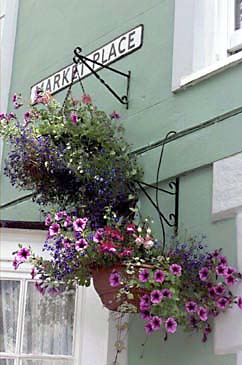 With
many of the cheaper megapixel-plus digital cameras the time
spent waiting between exposures is long - as much as fifteen
seconds. The DCS315 will capture a respectable three images
in one and a half seconds, before having to take a storage
'breather'. This alone is worth the 'professional' tag. ISO
range is 100 - 400.
With
many of the cheaper megapixel-plus digital cameras the time
spent waiting between exposures is long - as much as fifteen
seconds. The DCS315 will capture a respectable three images
in one and a half seconds, before having to take a storage
'breather'. This alone is worth the 'professional' tag. ISO
range is 100 - 400.
No batteries are supplied with the camera, though the good news is that six standard AA batteries are used, carried in a special tray. This makes battery changing easy, quick and inexpensive. Nickel Metal Hydride (NiMH) batteries can now be obtained in ratings of 1200 or 1300mAh - twice the capacity of Nickel Cadmium - but note that they do require a special charger.
Like its big-brother DCS520, the '315 has FireWire output, for ultra-rapid acquisition of images. This is no problem in the studio, where FireWire cards may be fitted into desktop computers but the only laptops which have FireWire built-in are the neat new VAIO ('Video Audio In Out') range from Sony. Of course, most laptops have PCMCIA card readers built-in, so it's a simple job to take the card out of the camera and pop it into a laptop. Kodak should be congratulated on adopting FireWire, though they must be quite disappointed that the inventors, Apple Computer, have not yet implemented it in their Macs-hines.
The basic camera costs £3,995 but the only supplied accessories are a hand strap, extra battery tray and 52mm Hot Metal filter. The chip in the DCS315 has hightened infrared sensitivity and the Hot Mirror reflects most infrared light, especially between 800 and 1200 nanometers, to offset this. It's a drag having to change the filter to your other lenses and additional Hot Mirror filters are expensive: the 77mm filter required for the 80 - 200 zoom is US$139.95 at B&H Photo in New York. It would be at least £100 here in the UK.
A virtually essential accessory pack containing a PCMCIA hard drive PC card, 24 - 70mm Nikon IX lens, AC power adapter, universal adapter plug kit, extra battery tray and FireWire cable costs £995, bringing the total price up to £4,990.
The DCS315 is well positioned as an entry-level professional digital camera with good 1.5 megapixel chip. But other cameras now offer pictures which approach its quality for a fraction of the cost - if not with the same degree of professional control. My pictures of the DCS315 were taken with such a camera, to be released at Photokina, about which I am not yet permitted to speak but which will probably cost in the region of £595 - £795. The DCS315 uses a well-established CCD. It should be easier to obtain than - and costs less than half the price of - the DCS520. You'll enjoy using it.
|
PROS |
CONS |
|
• Single Lens Reflex |
• Inaccurate viewfinder |
|
• Interchangeable lenses |
• Requires front-of-lens Hot Mirror filters |
|
• Standard off-the-shelf batteries |
• Focal length magnification 2.6x using 35mm lenses, 1.7x using APS lenses |
|
• On-board processing of JPEG images |
• Older design CCD used has more 'noise' |
|
• 1520 x 1008 pixel (1.5 megapixel) CCD |
• Essential accessories make total cost £4,990 |
|
• ISO range 100 to 400 |
|
|
• 2 images per second for 3 image burst |
|
|
• FireWire (IEEE 1394) output |
|
|
• Another good Kodak design |
|
|
• Less than half price of DCS520 |
This article first appeared in "John Henshall's Chip Shop", July/August 1998.
IMPORTANT
NOTICE
This document is Copyright © 1998 John Henshall. All
rights reserved.
This material may only be downloaded for personal
non-commercial use. Please safeguard the future of online
publishing by respecting this copyright and the rights of
all other authors of material on the Internet.